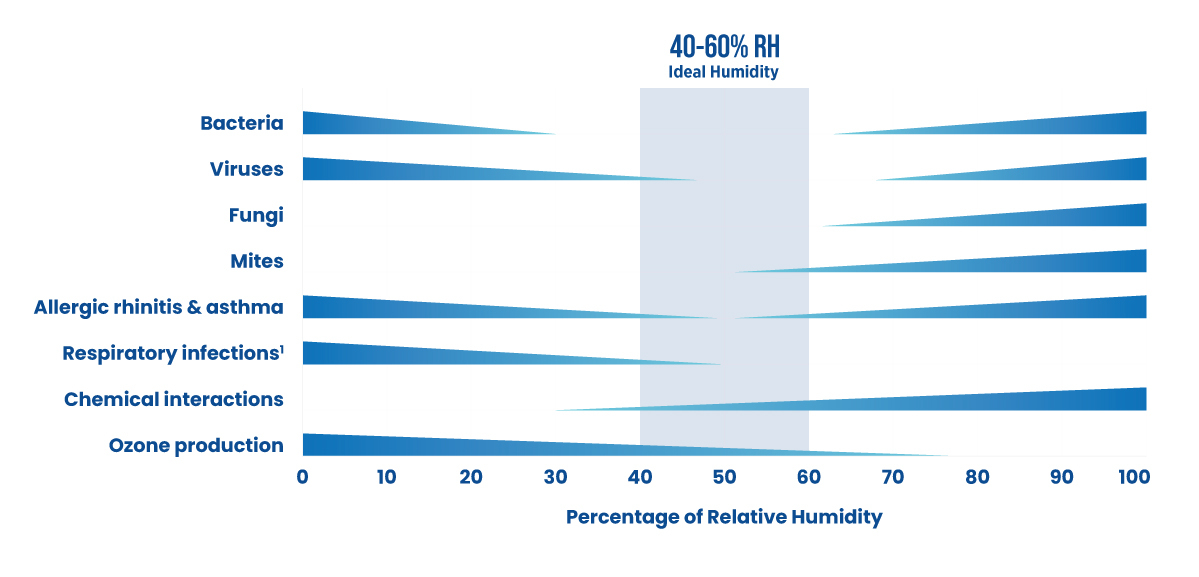Have you ever noticed that your home sometimes feels too dry or uncomfortably damp? The secret to feeling comfortable and keeping your space healthy might be hidden in the air around you.
Understanding the recommended indoor humidity levels can make a big difference in your comfort, health, and even the condition of your furniture and walls. If you want to breathe easier, protect your belongings, and create the perfect atmosphere inside your home, keep reading.
This guide will show you exactly what humidity level you should aim for and why it matters more than you think.
Ideal Humidity Range
Maintaining the ideal indoor humidity range is key for a healthy home. Proper humidity levels protect your comfort and health. It also helps preserve furniture and walls. Too much or too little moisture can cause problems.
Why Humidity Matters
Humidity affects air quality and comfort inside your home. Low humidity can cause dry skin and sore throats. It can also increase static electricity. High humidity leads to mold growth and dust mites. These can trigger allergies and breathing problems. Proper humidity helps protect your home and your health.
Recommended Levels For Different Rooms
Different rooms need different humidity levels for best comfort. Living rooms and bedrooms do well with 30% to 50% humidity. Kitchens and bathrooms often have higher moisture. Keep humidity below 60% to prevent mold there. Basements should stay between 30% and 50% to avoid dampness. Adjust levels with a humidifier or dehumidifier if needed.
Health Benefits
Maintaining the right indoor humidity level has clear health benefits. It creates a comfortable environment that supports well-being. Proper humidity helps reduce common health problems and boosts overall comfort inside your home or office.
Reducing Respiratory Issues
Dry air can irritate your nose and throat. It may cause coughing and difficulty breathing. Proper humidity keeps airways moist and helps reduce these problems. It lowers the risk of infections by stopping germs from spreading easily. Balanced humidity also helps people with asthma or allergies breathe better.
Improving Skin And Comfort
Low humidity dries out your skin and lips. This causes itching and discomfort. The right humidity level keeps skin hydrated and soft. It also reduces irritation and redness. Comfortable air makes it easier to relax and sleep well. Proper humidity supports a healthy, pleasant living space.
Effects Of Low Humidity
Low humidity inside homes can cause many problems. It makes the air dry and uncomfortable. This dryness affects our skin, health, and overall comfort. Understanding these effects helps us keep indoor air healthier.
Dry Skin And Irritation
Low humidity pulls moisture from the skin. This causes dryness, itchiness, and flaking. People may notice rough, cracked skin on hands and face. Lips can become chapped and sore. Dry air also irritates eyes and throat. These issues often get worse in winter months.
Increased Allergies And Infections
Dry air can worsen allergy symptoms. It allows dust and allergens to spread more easily. Low humidity weakens the body’s defenses. This makes it easier to catch colds and flu. Viruses survive longer in dry air. Keeping humidity at a good level helps lower health risks.

Credit: www.lennox.com
Effects Of High Humidity
High humidity inside the home can cause many problems. It makes the air feel sticky and uncomfortable. More than that, it creates an environment where harmful things can grow and spread. Understanding these effects can help you keep your home safe and healthy.
Mold And Mildew Growth
Excess moisture in the air feeds mold and mildew. These fungi grow on walls, ceilings, and furniture. Mold spores can cause health problems like coughing and sneezing. Mildew leaves a musty smell and stains surfaces. Removing mold is hard and costly. Controlling humidity levels helps stop mold from growing.
Dust Mites And Allergens
Dust mites thrive in humid conditions. They are tiny bugs that live in dust and bedding. These mites produce allergens that can cause allergies. High humidity increases their numbers fast. Allergens can trigger asthma attacks and skin irritation. Lowering indoor humidity reduces dust mites and allergens.
Measuring Indoor Humidity
Measuring indoor humidity helps keep your home comfortable and healthy. It tells you how much moisture is in the air. Too much moisture can cause mold and dust mites. Too little can dry out your skin and damage wood furniture.
Using the right tools and placing them correctly gives you the best reading. This section explains types of hygrometers and ideal placement for accurate results.
Types Of Hygrometers
Hygrometers measure the moisture level in the air. There are two main types: analog and digital. Analog hygrometers use a needle to show humidity. They are simple and do not need batteries. Digital hygrometers show numbers on a screen. They are easy to read and often more precise. Some digital models also measure temperature. Choose a hygrometer that fits your needs and budget.
Ideal Placement For Accuracy
Place the hygrometer away from windows and doors. Avoid spots near heaters, air conditioners, or vents. These areas can give false readings. Put the device at chest height in a central room. Keep it out of direct sunlight. Check the reading after the device stays in place for several hours. This helps ensure the data is stable and accurate.

Credit: blog.totalhomesupply.com
Controlling Humidity Levels
Controlling indoor humidity levels improves comfort and protects your home. Proper humidity helps reduce mold, dust mites, and bacteria. It also prevents damage to wood furniture and walls. Maintaining the right balance keeps the air fresh and healthy.
Using Humidifiers
Humidifiers add moisture to dry air. They work well during winter or in dry climates. Choose the right size for your room. Clean the humidifier often to avoid bacteria growth. Use distilled water to reduce mineral buildup. Set the device to keep humidity between 30% and 50%. This range feels comfortable and supports good health.
Dehumidifiers And Ventilation
Dehumidifiers remove excess moisture from the air. They help in damp or humid spaces like basements. Running a dehumidifier lowers humidity below 60%, preventing mold growth. Proper ventilation also controls humidity. Open windows or use exhaust fans in kitchens and bathrooms. Ventilation moves moist air outside, keeping indoor air dry and fresh.
Seasonal Humidity Tips
Indoor humidity changes with the seasons. Proper control keeps your home comfortable and healthy. Seasonal humidity tips help you adjust levels easily throughout the year.
Winter Adjustments
Cold air holds less moisture. Indoor air often becomes dry during winter. Use a humidifier to add moisture. Aim for 30-40% humidity to avoid dry skin and static electricity. Avoid too much moisture to prevent mold growth. Open windows briefly to freshen the air without losing heat.
Summer Strategies
Warm air can hold more moisture. Indoor humidity rises in summer. Use air conditioners or dehumidifiers to reduce moisture. Keep humidity around 40-60% for comfort and mold prevention. Ventilate kitchens and bathrooms to remove excess moisture. Use fans to improve air circulation and reduce dampness.
Common Mistakes To Avoid
Maintaining the right indoor humidity is important for comfort and health. Many people make simple mistakes that can cause problems. Avoiding these common errors helps keep your home safe and cozy.
Overhumidifying
Too much humidity can cause mold and dust mites. These lead to allergies and damage to furniture. Keep humidity levels between 30% and 50%. Use a reliable hygrometer to check moisture in the air. Avoid running humidifiers all day without breaks. Excess moisture can make your home feel damp and cold.
Ignoring Maintenance
Humidifiers and dehumidifiers need regular care. Dirty filters and tanks can spread bacteria. Clean your devices weekly to keep air fresh. Neglecting maintenance reduces their efficiency and lifespan. Check for leaks or cracks in your equipment. Proper upkeep saves money and improves air quality.

Credit: www.aprilaire.com
Frequently Asked Questions
What Is The Ideal Indoor Humidity Level?
The ideal indoor humidity level ranges from 30% to 50%. This range ensures comfort, prevents mold growth, and reduces allergens. Maintaining this balance promotes healthier air and protects furniture and electronics from damage.
How Does Humidity Affect Indoor Air Quality?
Humidity influences air quality by controlling moisture levels. Too much humidity encourages mold and dust mites. Too little causes dry skin and respiratory issues. Keeping humidity balanced improves comfort and reduces health risks.
Why Is 50% Humidity Recommended Indoors?
50% humidity is recommended as it balances comfort and health. It prevents mold growth and minimizes airborne viruses. This level also protects wooden furniture and musical instruments from damage.
How To Measure Indoor Humidity Accurately?
Use a hygrometer to measure indoor humidity accurately. Digital hygrometers provide precise readings and are easy to use. Regular monitoring helps maintain optimal humidity for comfort and health.
Conclusion
Maintaining the right indoor humidity keeps your home comfortable and healthy. Too much moisture can cause mold and dust mites. Too little dryness can lead to dry skin and breathing issues. Aim for 30% to 50% humidity for balance. Use a humidifier or dehumidifier to adjust levels.
Check humidity often with a simple meter. Small changes make a big difference in air quality. Healthy air supports better sleep and fewer allergies. Keep your indoor space fresh and safe with proper humidity. Easy steps lead to a happier home environment.



